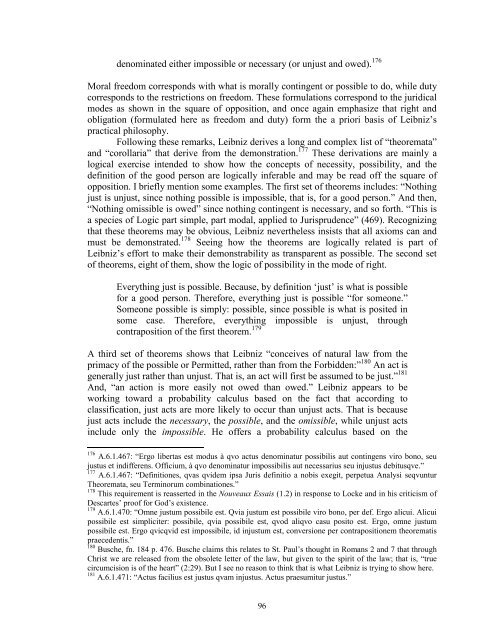Stony Brook University
Stony Brook University
Stony Brook University
Create successful ePaper yourself
Turn your PDF publications into a flip-book with our unique Google optimized e-Paper software.
denominated either impossible or necessary (or unjust and owed). 176<br />
Moral freedom corresponds with what is morally contingent or possible to do, while duty<br />
corresponds to the restrictions on freedom. These formulations correspond to the juridical<br />
modes as shown in the square of opposition, and once again emphasize that right and<br />
obligation (formulated here as freedom and duty) form the a priori basis of Leibniz’s<br />
practical philosophy.<br />
Following these remarks, Leibniz derives a long and complex list of “theoremata”<br />
and “corollaria” that derive from the demonstration. 177 These derivations are mainly a<br />
logical exercise intended to show how the concepts of necessity, possibility, and the<br />
definition of the good person are logically inferable and may be read off the square of<br />
opposition. I briefly mention some examples. The first set of theorems includes: “Nothing<br />
just is unjust, since nothing possible is impossible, that is, for a good person.” And then,<br />
“Nothing omissible is owed” since nothing contingent is necessary, and so forth. “This is<br />
a species of Logic part simple, part modal, applied to Jurisprudence” (469). Recognizing<br />
that these theorems may be obvious, Leibniz nevertheless insists that all axioms can and<br />
must be demonstrated. 178 Seeing how the theorems are logically related is part of<br />
Leibniz’s effort to make their demonstrability as transparent as possible. The second set<br />
of theorems, eight of them, show the logic of possibility in the mode of right.<br />
Everything just is possible. Because, by definition ‘just’ is what is possible<br />
for a good person. Therefore, everything just is possible “for someone.”<br />
Someone possible is simply: possible, since possible is what is posited in<br />
some case. Therefore, everything impossible is unjust, through<br />
contraposition of the first theorem. 179<br />
A third set of theorems shows that Leibniz “conceives of natural law from the<br />
primacy of the possible or Permitted, rather than from the Forbidden:” 180 An act is<br />
generally just rather than unjust. That is, an act will first be assumed to be just.” 181<br />
And, “an action is more easily not owed than owed.” Leibniz appears to be<br />
working toward a probability calculus based on the fact that according to<br />
classification, just acts are more likely to occur than unjust acts. That is because<br />
just acts include the necessary, the possible, and the omissible, while unjust acts<br />
include only the impossible. He offers a probability calculus based on the<br />
176 A.6.1.467: “Ergo libertas est modus à qvo actus denominatur possibilis aut contingens viro bono, seu<br />
justus et indifferens. Officium, à qvo denominatur impossibilis aut necessarius seu injustus debitusqve.”<br />
177 A.6.1.467: “Definitiones, qvas qvidem ipsa Juris definitio a nobis exegit, perpetua Analysi seqvuntur<br />
Theoremata, seu Terminorum combinationes.”<br />
178 This requirement is reasserted in the Nouveaux Essais (1.2) in response to Locke and in his criticism of<br />
Descartes’ proof for God’s existence.<br />
179 A.6.1.470: “Omne justum possibile est. Qvia justum est possibile viro bono, per def. Ergo alicui. Alicui<br />
possibile est simpliciter: possibile, qvia possibile est, qvod aliqvo casu posito est. Ergo, omne justum<br />
possibile est. Ergo qvicqvid est impossibile, id injustum est, conversione per contrapositionem theorematis<br />
praecedentis.”<br />
180 Busche, fn. 184 p. 476. Busche claims this relates to St. Paul’s thought in Romans 2 and 7 that through<br />
Christ we are released from the obsolete letter of the law, but given to the spirit of the law; that is, “true<br />
circumcision is of the heart” (2:29). But I see no reason to think that is what Leibniz is trying to show here.<br />
181 A.6.1.471: “Actus facilius est justus qvam injustus. Actus praesumitur justus.”<br />
96
















